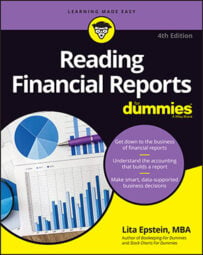Overstated assets make a company look financially healthier to annual report readers than it truly is. The company may report that it has more cash due than it really does, or that it holds more inventory than is actually on its shelves. The company may also report that the value of its inventory is greater than it really is.
Accounts receivable
The accounts receivable section of the financial report is the place where you may find an indication of premature or fictitious revenue recognition. One way a company can overstate its accounts receivable is to post sales to customers who will return the items early the following month without paying for them.
The dollar value of those goods reduces the accounts receivable during the next accounting period, but the deception makes the current period look like more revenues were received than should actually have been counted because the sales are premature or fictitious.
That deception isn't the only way a company can overvalue its accounts receivable. Another account attached to accounts receivable is the allowance for doubtful accounts. At the end of each accounting period, the company identifies past-due accounts that probably won't get paid and adds the value of these past-due accounts to the allowance for doubtful accounts, which reduces the value of accounts receivable.
A company that wants to play with its numbers and indicate that its financial position is actually better than it appears reduces the amount it sets aside for doubtful accounts. Gradually, the number of days the company takes to collect on its accounts receivable goes up as more late- or nonpayers are left in accounts receivable.
Eventually, the number of days it takes for the company to collect on its accounts receivable goes up, and the amount of cash it takes in from customers who are paying off their purchase bought on credit slows down.
Test the trend by calculating days in accounts receivable for the past three to five quarters. If you see the number of days in accounts receivable gradually rise, it's a sign of a problem, and it may represent an attempt to recognize revenue prematurely or fictitiously. But it may also represent a problem of credit policies that are too liberal.
Inventory
Companies can use one of five different inventory valuation methods, and each one yields a different net income for the company. Inventory policy isn't the only way a company can shift the value of its inventory on the balance sheet. Other common methods used include the following:
Overstating physical count: Although this method is absolute fraud, companies take this route to improve the appearance of their balance sheets. Sometimes they alter the actual count of their inventory; other times they don't subtract the decrease in inventory from the physical count. Companies may also leave damaged goods in the inventory count, even though they have no value.
Increasing reported valuation: Some businesses don't even bother messing with their inventory counts. A simple journal entry increasing a firm's inventory valuation and decreasing its costs of goods sold can improve appearances on both the balance sheet and the income statement. The assets side of the balance sheet looks better, and the net income figure improves, too.
Delaying an inventory write-down: Company management periodically writes down the value of inventory when it determines that the products are obsolete or slow moving. Because the decision to write down inventory is purely up to management, during a rough year, the company may delay writing down inventory to make its numbers look better.
Any time you suspect that inventory may be the object of financial game playing, you can test your theory by calculating the number of days inventory sits around the company. Look for trends by running the numbers for the past three years. If you see that the number of days that inventory sits around gradually increases, definitely suspect a problem.
The problem may not be creative accounting; it may be a sign of other problems, such as reduced consumer interest in the product or a bad economic market. The only way to find out is to ask your questions to the company's investor relations department.
Undeveloped land
Land never depreciates. But shareholders don't have any details about where the land that a company owns is located, so they can never truly assess the value of undeveloped land on a balance sheet. This fact allows a lot of room for creative accounting and leaves the financial reader in the dark when it comes to finding this problem.
Unfortunately, in a sketchy situation like this one, all you can do is wait for a whistle-blower to expose it.
Artwork
As is the case with undeveloped land, financial reports don't detail the value of artwork that a company holds, so a lot of room exists for doctoring the numbers.
Unless you're looking at the financial statements for a company that regularly sells artwork, be wary when you see a large portion of its assets listed on the balance sheet in a line item called artwork. This line item shouldn't be a major one for most companies that aren't in the art business.
If you see a non-art business with a significant level of assets tied up in artwork, ask investor relations why the company is spending so much money on art. Frankly, a firm that ties up its money in art instead of using it to grow the business is probably not one you want to own stock in.

